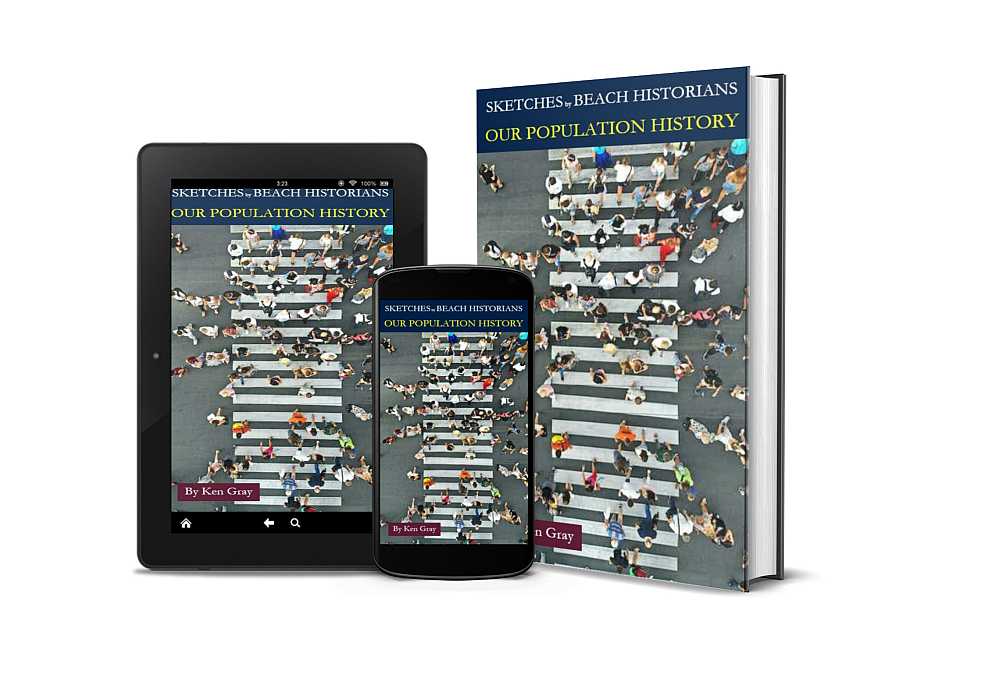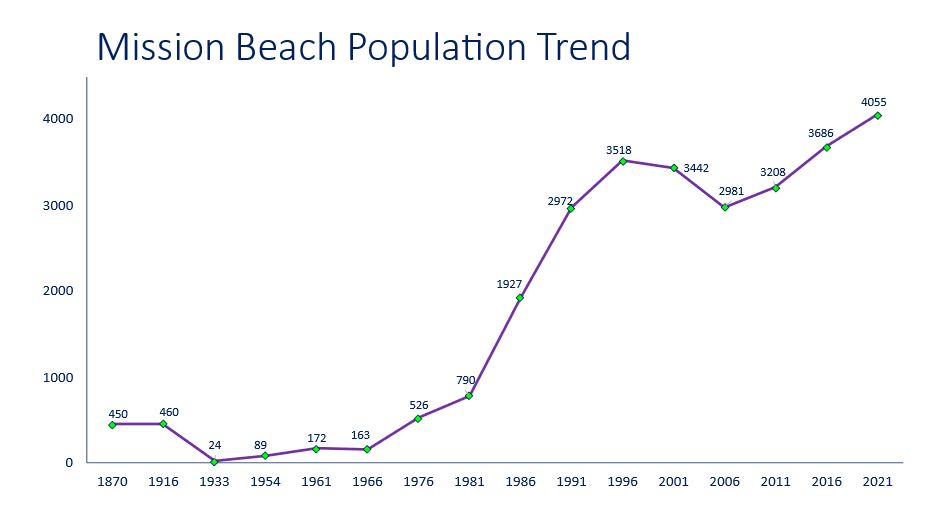Author: Ken Gray
Editors: Chris Forbes & Diane Bull
 |
Download PDF |
This Sketch examines the history of Mission Beach’s population changes and briefly looks at the growth patterns of some other towns in the Cassowary Coast region.
For these purposes, the town of Mission Beach is defined as the area where many residents will say Mission Beach when asked by interstate people where they live. That means people living in the settlements at Carmoo, the Family Islands, South Mission Beach, Wongaling Beach, Mission Beach, Narragon Beach, Bingil Bay, Brookes Beach, Garners Beach, Midgereebar and Maria Creek. In 2016, the time of the last census, the 4852 Post Code area boundaries (shown below) covered all these ‘Mission Beach’ villages apart from Maria Creek.
 Mission Beach as defined by the 4852 Post Code, from the Australian Bureau of Statistics.
Mission Beach as defined by the 4852 Post Code, from the Australian Bureau of Statistics.
The population of ‘Mission Beach’ as defined by Post Code 4852 was 3,686 at the 2016 census, and late in 2022 there will be new census data available for 2021. The chart below shows how the population has changed since 1870. The first European settlers, the Cutten family, settled at Bingil Bay in 1885.
Estimating the population in 1870 is difficult, but we accessed several studies and found the Djiru population was approximately 450. Djiru country covers a slightly larger area than 4852, so perhaps the population was a little lower. In 2022, there are only 11 Djiru people living on their traditional lands.
The population in 1916 was largely First Nations people when, in 1914, many people were forcibly removed from across the Cape to the Hull River Aboriginal Settlement. Using data derived from the electoral rolls, the population in 1916 was between 460 and 490, including 400 at the Aboriginal Settlement. The European population had been growing since 1910 when banana farms were viable for a time. It declined quickly when WWI intervened, and by 1917, almost no shipping was available, so most farmers left the district. Disease hit the Aboriginal Settlement hard in 1917 with up to 200 lives being lost. Then the devastating 1918 cyclone left the Aboriginal Settlement in ruins, the remaining inmates fled or were sent to Palm Island. The area was left with a tiny remnant population of resilient farmers.
For the next 30 years, growth was slow and it was not until the 1970s that the population reached its 1870 population levels. Initially, an influx of banana farmers caused the growth, then tourism started to kick in. The steep growth in the 1980s was all driven by tourism.
Until recently, the only way to determine the full population of the town has been to add up the populations of the separate villages. Accuracy of population estimates has sharpened since 1991 with better data available. In 2016, the populations by village were: Wongaling Beach 1,245, South Mission Beach 932, Mission Beach 815, Bingil Bay 427, Carmoo 178, Maria Creeks 121, Midgereebar 49, Garners Beach 25 and Family Islands 21; a total of 3,813. However, the Maria Creeks area includes parts more properly assigned to El Arish, so, if we adjust that down based on aerial mapping, the total is 3,742. For the chart above, the 2016 Post Code 4852 populations were used for 2016 and 2021.
Settlement started in Bingil Bay, then Mission Beach (north) became the growth node early on. Recently, growth has come mainly from Wongaling and South Mission Beach where more residential land is available. The town’s population declined from 1996 to 2006 then grew again thereafter. Several factors caused the hiatus, most relating to setbacks for tourism. Three severe cyclones in 26 years did not help, and some of the large tourism infrastructure is yet to be rebuilt.
Growth of the Cassowary Coast region for the 50 years from 1966 to 2016 was merely 0.6% pa; under a third of the growth of all Australia in that period (2.15% pa.) The region’s growth contracted from 1996 to 2006 and picked up quite strongly again in the next two census periods.
Half the Cassowary Coast region’s population increase in the 50 years from 1966 to 2016 was generated by growth at Mission Beach.
Pete Faulkner, the region’s economist at Conus Business Consultancy, analysed our town populations down to the finest levels of detail following the 2016 census. He included near ‘suburbs’ to place all of the towns on a level footing. Pete reported that the region’s four largest towns in 2016 were Innisfail 11,206; Mission Beach 3,913;[1] Tully 2,967 and Cardwell 1,574.
Innisfail
Innisfail grew slowly yet steadily by an average of 0.5% pa from 1966 to 2016. It peaked in population in 2001 and has largely been static since. Innisfail remains the dominant town for the region.
Tully
Tully’s population grew quickly after they belatedly gained their sugar mill in 1925. It peaked early, in 1966 and it has shown a slow yet steady decline, thereafter, losing 0.3% pa for 50 years. While Tully is no longer the second largest town in the region, it services the second largest catchment area with 5,525 people living in its Post Code area, 4854 in 2021.
Cardwell
Cardwell has grown quite quickly from a small base of only 440 in 1966 to 1,309 in 2016. However, it declined by over 1% pa for 15 years between 1996 to 2011, then showed some growth in the last two census periods. Cardwell was settled in 1864, being the first town to start north of Bowen. Early settlers (mainly Dalrymple) talked Cardwell up as the next big thing and said its harbour was similar to Sydney’s. That was a huge fib and its shallow harbour caused Cardwell’s rapid demise, giving way soon after to Townsville then Cairns. Hopefully, Cardwell will grow as it is an important part of our region’s tourism.
Kurrimine
Kurrimine has grown in a similar pattern to Mission Beach but at a slower pace. The population in 2001 was 828, but it has decreased since to 742 in 2021. It is another of the region’s tourism nodes.
El Arish
By 1961, El Arish with its timber mills and sugar cane farms was booming with 775 people, and it had a rosy future. However, as with most small towns in the region, its sugar-based economy was hit badly by the mechanization of cane farming. It suffered a double whammy when the forests were protected and the timber mills closed. From 1966, it went into steep decline and by 2006, its population was down to a third of what it had been. In 2011, the population rose but that was merely due to a change in the boundaries used by the Bureau of Statistics. Numbers declined again quite badly in 2016 and 2021.
The sugar-town pattern of steep declines was the major factor limiting growth in the overall region from 1961 on. The good news for the region is that the decline in labour needed for sugar is well past us. The largest industries for the region remain sugar and bananas.
Regional growth will, however, depend largely on the success of our efforts to develop, support and promote the tourist industry. There has been a chequered history on that front.
The way the Bureau of Statistics assembles its data on Mission Beach is somewhat problematic. There is still no ability to access data easily on the total town population. Hence, when someone asks what the population of Mission Beach is, they are reflexly told 815, when it is actually 3,686.
Mission Beach is the hub of the region’s budding tourism industry. It has incredibly beautiful and valuable tourism assets in its diverse beaches, forests, islands and wildlife. There are so many other valuable tourism assets of note nearby in the region. The question is, can we move on from a past of parochialism and petty jealousy between towns and work in harmony to promote and develop the destination? It took 18 years for the town to win small amounts of funding for its vital aquatic centre infrastructure with many Councillors refusing to budge and preferring to invest in their own territories.
If we act as one on tourism, the future for the region can be different. The full region will thrive and all towns will benefit. The next growth cycle can be driven by tourism if we are able to learn from our past.
[1] Adjusted down slightly in my charts to take out part of the Maria Creeks collection.
 |
Download PDF |





